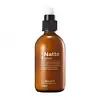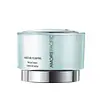What's inside
What's inside
 Key Ingredients
Key Ingredients

 Benefits
Benefits

 Concerns
Concerns

 Ingredients Side-by-side
Ingredients Side-by-side

Water
Skin ConditioningGlycerin
HumectantButylene Glycol
HumectantSqualane
EmollientHelianthus Annuus Seed Oil
EmollientPolyglyceryl-3 Methylglucose Distearate
Emulsifying1,2-Hexanediol
Skin ConditioningBacillus
Skin ConditioningGlyceryl Stearate
EmollientPEG-100 Stearate
Lithospermum Officinale Root Extract
Skin ConditioningPhenoxyethanol
PreservativeDimethicone
EmollientBacillus/Glutamic Acid Ferment Filtrate
Skin ConditioningPortulaca Oleracea Extract
Skin ConditioningPolyacrylate-13
Ethylhexylglycerin
Skin ConditioningXanthan Gum
EmulsifyingTocopheryl Acetate
AntioxidantSodium Polyglutamate
HumectantButyrospermum Parkii Butter
Skin ConditioningPolyisobutene
Palmitic Acid
EmollientPanthenol
Skin ConditioningCeramide NP
Skin ConditioningAllantoin
Skin ConditioningStearic Acid
CleansingScutellaria Baicalensis Root Extract
AstringentPolysorbate 20
EmulsifyingSorbitan Isostearate
EmulsifyingBeta-Glucan
Skin ConditioningAsiaticoside
AntioxidantBackhousia Citriodora Leaf Oil
MaskingEucalyptus Dives Leaf Oil
PerfumingMadecassic Acid
Skin ConditioningAsiatic Acid
Skin ConditioningFusanus Spicatus Wood Oil
MaskingLimonene
PerfumingCitral
PerfumingFarnesol
PerfumingWater, Glycerin, Butylene Glycol, Squalane, Helianthus Annuus Seed Oil, Polyglyceryl-3 Methylglucose Distearate, 1,2-Hexanediol, Bacillus, Glyceryl Stearate, PEG-100 Stearate, Lithospermum Officinale Root Extract, Phenoxyethanol, Dimethicone, Bacillus/Glutamic Acid Ferment Filtrate, Portulaca Oleracea Extract, Polyacrylate-13, Ethylhexylglycerin, Xanthan Gum, Tocopheryl Acetate, Sodium Polyglutamate, Butyrospermum Parkii Butter, Polyisobutene, Palmitic Acid, Panthenol, Ceramide NP, Allantoin, Stearic Acid, Scutellaria Baicalensis Root Extract, Polysorbate 20, Sorbitan Isostearate, Beta-Glucan, Asiaticoside, Backhousia Citriodora Leaf Oil, Eucalyptus Dives Leaf Oil, Madecassic Acid, Asiatic Acid, Fusanus Spicatus Wood Oil, Limonene, Citral, Farnesol
Phyllostachys Bambusoides Juice
Skin ConditioningWater
Skin ConditioningButyrospermum Parkii Butter
Skin ConditioningGlycerin
HumectantPropanediol
SolventMethyl Trimethicone
Skin ConditioningPentaerythrityl Tetraethylhexanoate
EmollientButylene Glycol
HumectantAlcohol
AntimicrobialCamellia Sinensis Seed Oil
Humectant1,2-Hexanediol
Skin ConditioningSqualane
EmollientLimnanthes Alba Seed Oil
Skin ConditioningSodium Carbomer
Emulsion StabilisingPanthenol
Skin ConditioningHydrogenated Lecithin
EmulsifyingPhytosteryl/Behenyl/Octyldodecyl Lauroyl Glutamate
Skin ConditioningTocopherol
AntioxidantCeramide NP
Skin ConditioningCholesterol
EmollientParfum
MaskingPhenoxyethanol
PreservativeXanthan Gum
EmulsifyingGlyceryl Caprylate
EmollientStearic Acid
CleansingEthylhexylglycerin
Skin ConditioningAdenosine
Skin ConditioningPalmitic Acid
EmollientLinalool
PerfumingButylphenyl Methylpropional
PerfumingLimonene
PerfumingGeraniol
PerfumingAlpha-Isomethyl Ionone
PerfumingCitronellol
PerfumingNelumbo Nucifera Flower Extract
Skin ConditioningCamellia Sinensis Leaf Extract
AntimicrobialCaprylyl Glycol
EmollientCitric Acid
BufferingPhytantriol
HumectantPoloxamer 407
EmulsifyingAmmonium Acryloyldimethyltaurate/Vp Copolymer
Caffeine
Skin ConditioningTheanine
EmollientEpigallocatechin Gallate
AntioxidantKaempferol
AntioxidantCamellia Sinensis Flower Extract
PerfumingPhyllostachys Bambusoides Juice, Water, Butyrospermum Parkii Butter, Glycerin, Propanediol, Methyl Trimethicone, Pentaerythrityl Tetraethylhexanoate, Butylene Glycol, Alcohol, Camellia Sinensis Seed Oil, 1,2-Hexanediol, Squalane, Limnanthes Alba Seed Oil, Sodium Carbomer, Panthenol, Hydrogenated Lecithin, Phytosteryl/Behenyl/Octyldodecyl Lauroyl Glutamate, Tocopherol, Ceramide NP, Cholesterol, Parfum, Phenoxyethanol, Xanthan Gum, Glyceryl Caprylate, Stearic Acid, Ethylhexylglycerin, Adenosine, Palmitic Acid, Linalool, Butylphenyl Methylpropional, Limonene, Geraniol, Alpha-Isomethyl Ionone, Citronellol, Nelumbo Nucifera Flower Extract, Camellia Sinensis Leaf Extract, Caprylyl Glycol, Citric Acid, Phytantriol, Poloxamer 407, Ammonium Acryloyldimethyltaurate/Vp Copolymer, Caffeine, Theanine, Epigallocatechin Gallate, Kaempferol, Camellia Sinensis Flower Extract
 Reviews
Reviews

Ingredients Explained
These ingredients are found in both products.
Ingredients higher up in an ingredient list are typically present in a larger amount.
1,2-Hexanediol is a synthetic liquid and another multi-functional powerhouse.
It is a:
- Humectant, drawing moisture into the skin
- Emollient, helping to soften skin
- Solvent, dispersing and stabilizing formulas
- Preservative booster, enhancing the antimicrobial activity of other preservatives
Butylene Glycol (or BG) is used within cosmetic products for a few different reasons:
Overall, Butylene Glycol is a safe and well-rounded ingredient that works well with other ingredients.
Though this ingredient works well with most skin types, some people with sensitive skin may experience a reaction such as allergic rashes, closed comedones, or itchiness.
Learn more about Butylene GlycolThis ingredient is also known as shea butter. It is an effective skin hydrator and emollient.
Emollients help soothe and soften your skin. It does this by creating a protective film on your skin. This barrier helps trap moisture and keeps your skin hydrated. Emollients may be effective at treating dry or itchy skin.
Shea butter is rich in antioxidants. Antioxidants help fight free-radicals, or molecules that may harm the body. It is also full of fatty acids including stearic acid and linoleic acid. These acids help replenish the skin and keep skin moisturized.
While Shea Butter has an SPF rating of about 3-4, it is not a sunscreen replacement.
Shea butter may not be fungal acne safe. We recommend speaking with a professional if you have any concerns.
Learn more about Butyrospermum Parkii ButterCeramide NP is a type of ceramide and formally known as ceramide 3.
Ceramides are intercellular lipids naturally found in our skin that bonds dead skin cells together to create a barrier. They are known for their ability to hold water and thus are a great ingredient for dry skin.
Ceramides are an important building block for our skin barrier. A stronger barrier helps the skin look more firm and hydrated. By bolstering the skin ceramides act as a barrier against irritating ingredients. This can help with inflammation as well.
If you would like to eat ceramides, sweet potatoes contain a small amount.
Read more about other common types of ceramides here:
Ceramide AP
Ceramide EOP
Ethylhexylglycerin (we can't pronounce this either) is commonly used as a preservative and skin softener. It is derived from glyceryl.
You might see Ethylhexylglycerin often paired with other preservatives such as phenoxyethanol. Ethylhexylglycerin has been found to increase the effectiveness of these other preservatives.
Glycerin is already naturally found in your skin. It helps moisturize and protect your skin.
A study from 2016 found glycerin to be more effective as a humectant than AHAs and hyaluronic acid.
As a humectant, it helps the skin stay hydrated by pulling moisture to your skin. The low molecular weight of glycerin allows it to pull moisture into the deeper layers of your skin.
Hydrated skin improves your skin barrier; Your skin barrier helps protect against irritants and bacteria.
Glycerin has also been found to have antimicrobial and antiviral properties. Due to these properties, glycerin is often used in wound and burn treatments.
In cosmetics, glycerin is usually derived from plants such as soybean or palm. However, it can also be sourced from animals, such as tallow or animal fat.
This ingredient is organic, colorless, odorless, and non-toxic.
Glycerin is the name for this ingredient in American English. British English uses Glycerol/Glycerine.
Learn more about GlycerinLimonene is a fragrance that adds scent and taste to a formulation.
It's found in the peel oil of citrus fruits and other plants such as lavender and eucalyptus. The scent of limonene is generally described as "sweet citrus".
Limonene acts as an antioxidant, meaning it helps neutralize free radicals.
When exposed to air, oxidized limonene may sensitize the skin. Because of this, limonene is often avoided by people with sensitive skin.
The term 'fragrance' is not regulated in many countries. In many cases, it is up to the brand to define this term. For instance, many brands choose to label themselves as "fragrance-free" because they are not using synthetic fragrances. However, their products may still contain ingredients such as essential oils that are considered a fragrance.
Learn more about LimonenePalmitic Acid is a fatty acid naturally found in our skin and in many plant and animal sources. In cosmetics, it is usually derived from palm oil. It serves many purposes in skincare, acting as a cleanser, emollient, and emulsifier.
As an emollient, palmitic acid helps soften and smooth the skin by preventing water loss. In cleansers, it helps remove oil and dirt while creating foam.
Its emulsifying properties help stabilize products by keeping water and oil-based ingredients from separating.
This may not be suitable for fungal acne-prone skin, as fatty acids like this can sometimes trigger breakouts in sensitive individuals.
Learn more about Palmitic AcidPanthenol is a common ingredient that helps hydrate and soothe the skin. It is found naturally in our skin and hair.
There are two forms of panthenol: D and L.
D-panthenol is also known as dexpanthenol. Most cosmetics use dexpanthenol or a mixture of D and L-panthenol.
Panthenol is famous due to its ability to go deeper into the skin's layers. Using this ingredient has numerous pros (and no cons):
Like hyaluronic acid, panthenol is a humectant. Humectants are able to bind and hold large amounts of water to keep skin hydrated.
This ingredient works well for wound healing. It works by increasing tissue in the wound and helps close open wounds.
Once oxidized, panthenol converts to pantothenic acid. Panthothenic acid is found in all living cells.
This ingredient is also referred to as pro-vitamin B5.
Learn more about PanthenolPhenoxyethanol is a preservative that has germicide, antimicrobial, and aromatic properties. Studies show that phenoxyethanol can prevent microbial growth. By itself, it has a scent that is similar to that of a rose.
It's often used in formulations along with Caprylyl Glycol to preserve the shelf life of products.
Squalane is an emollient that helps the skin hold onto moisture. It's an oily liquid that occurs naturally in certain types of fish and plant oils.
Because squalane boosts hydration in the skin, it also comes with plenty of benefits: it is an antioxidant and can help fight free radicals and skin damage. Squalane is also found to have a detoxifying effect when applied.
Squalane comes from squalene, which occurs naturally within the sebum of our skin. It is one of the oils our skin produces to keep itself hydrated. Squalane is the hydrogenated version of squalene and has a longer shelf life.
Research shows that squalane is non-irritating (even at 100% concentration).
In general, it's a fantastic ingredient. It does a great job at hydrating the skin, and it's suitable for those with sensitive skin.
The source of squalane may impact malassezia / fungal acne. This is because olive oil derived squalane can contain impurities such as fatty acids and plant waxes. Sugarcane derived squalane is recommended for anyone with malassezia concerns.
Is squalane vegan?
This depends on the source. Squalane can be derived from both plants and animals. Most squalane used in skincare comes from plants.
Please note: the source of squalane is only known if disclosed by the brand. We recommend reaching out to the brand if you have any questions about their squalane.
Read more about squalene with an "e".
Is squalane an oil?
Squalane is often called an oil, but it’s technically not; it’s a hydrocarbon, meaning it’s only made of carbon and hydrogen, unlike true oils which are triglycerides made of fatty acids and glycerol.
The term “oil-free” isn’t regulated, so companies can define it however they want. Some exclude all oils, while others just avoid mineral oil or comedogenic oils.
While some people avoid oils thinking they cause breakouts, the right kind of oil (or oil-like ingredient like squalane) can actually help balance and hydrate your skin. It’s worth testing out simple oils or squalane to see what works best for your skin.
Learn more about SqualaneStearic Acid is a fatty acid. It is an emollient, emulsifier, and texture enhancer.
As an emollient, stearic acid helps soften skin. It aids the skin's protective barrier by preventing water loss. It also provides a gentle cleansing effect without stripping away natural oils.
Stearic acid may also be used to enhance the texture of products. It can add volume and stabilize ingredients such as water and oil. This can help water and oil ingredients from separating.
Sources of stearic acid include animal or vegetable fats/oils such as coconut or shea. It can be naturally found in butter, cocoa butter, shea butter, vegetable fats, and animal tallow.
This ingredient may not be Malassezia folliculitis, or fungal-acne safe.
Learn more about Stearic AcidWater. It's the most common cosmetic ingredient of all. You'll usually see it at the top of ingredient lists, meaning that it makes up the largest part of the product.
So why is it so popular? Water most often acts as a solvent - this means that it helps dissolve other ingredients into the formulation.
You'll also recognize water as that liquid we all need to stay alive. If you see this, drink a glass of water. Stay hydrated!
Learn more about WaterXanthan gum is used as a stabilizer and thickener within cosmetic products. It helps give products a sticky, thick feeling - preventing them from being too runny.
On the technical side of things, xanthan gum is a polysaccharide - a combination consisting of multiple sugar molecules bonded together.
Xanthan gum is a pretty common and great ingredient. It is a natural, non-toxic, non-irritating ingredient that is also commonly used in food products.
Learn more about Xanthan Gum